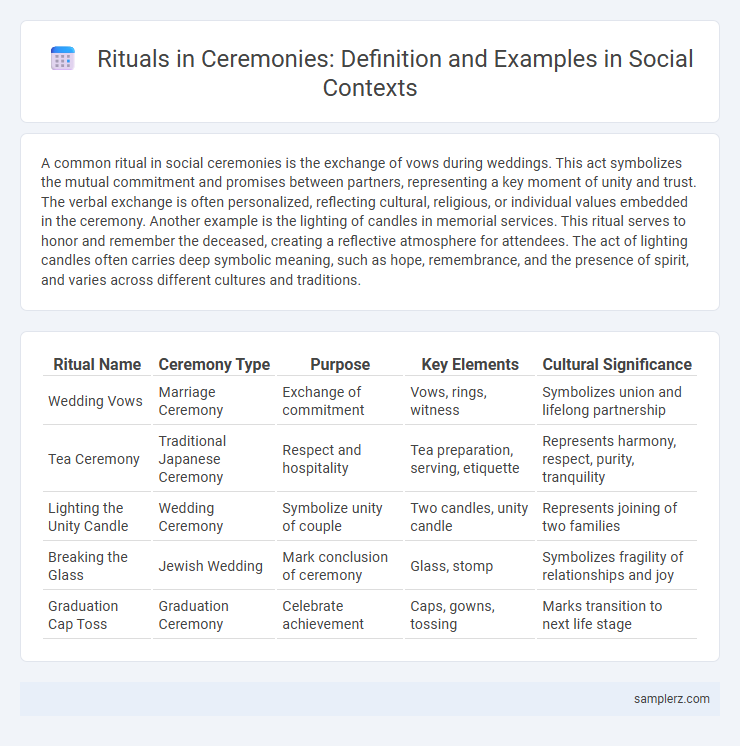A common ritual in social ceremonies is the exchange of vows during weddings. This act symbolizes the mutual commitment and promises between partners, representing a key moment of unity and trust. The verbal exchange is often personalized, reflecting cultural, religious, or individual values embedded in the ceremony. Another example is the lighting of candles in memorial services. This ritual serves to honor and remember the deceased, creating a reflective atmosphere for attendees. The act of lighting candles often carries deep symbolic meaning, such as hope, remembrance, and the presence of spirit, and varies across different cultures and traditions.
Table of Comparison
| Ritual Name | Ceremony Type | Purpose | Key Elements | Cultural Significance |
|---|---|---|---|---|
| Wedding Vows | Marriage Ceremony | Exchange of commitment | Vows, rings, witness | Symbolizes union and lifelong partnership |
| Tea Ceremony | Traditional Japanese Ceremony | Respect and hospitality | Tea preparation, serving, etiquette | Represents harmony, respect, purity, tranquility |
| Lighting the Unity Candle | Wedding Ceremony | Symbolize unity of couple | Two candles, unity candle | Represents joining of two families |
| Breaking the Glass | Jewish Wedding | Mark conclusion of ceremony | Glass, stomp | Symbolizes fragility of relationships and joy |
| Graduation Cap Toss | Graduation Ceremony | Celebrate achievement | Caps, gowns, tossing | Marks transition to next life stage |
Symbolic Acts in Social Gatherings
Symbolic acts in social gatherings, such as the lighting of candles during weddings, serve to unify participants and convey shared values and intentions. The exchange of garlands in Indian ceremonies signifies respect and acceptance between families, reinforcing communal bonds. Toasting in Western celebrations symbolizes goodwill and collective joy, embedding cultural meanings within the ritual.
Key Rituals in Traditional Ceremonies
Key rituals in traditional ceremonies often include symbolic actions such as exchanging garlands, lighting candles, or offering prayers to deities. These rituals serve to invoke blessings, signify unity, or mark the transition between life stages, deeply rooted in cultural heritage. The precise steps, attire, and chants used during these rituals vary by region and community, reflecting unique social values and beliefs.
Common Practices at Social Celebrations
In social celebrations, common practices include exchanging gifts, sharing meals, and performing traditional dances that symbolize unity and cultural heritage. Lighting candles or fireworks often marks the commencement or conclusion of ceremonies, enhancing the festive atmosphere. These rituals foster social bonds and reinforce collective identity among participants.
The Role of Music and Dance in Rituals
Music and dance play a pivotal role in rituals by fostering communal bonds and enhancing emotional expression during ceremonies. Rhythmic drums, melodic chants, and synchronized movements create a multisensory experience that symbolizes cultural values and spiritual beliefs. These performative elements often facilitate transitions, marking significant life events such as weddings, funerals, and initiation rites.
Gift-Giving as a Ceremonial Ritual
Gift-giving as a ceremonial ritual symbolizes social bonds and cultural values through the exchange of meaningful objects during events such as weddings, graduations, and religious ceremonies. This practice reinforces relationships, conveys respect, and reflects community identity by adhering to traditional protocols and significance. In many cultures, the type, timing, and presentation of gifts are carefully prescribed to honor the occasion and participants.
Processions and Parades: Ceremonial Highlights
Processions and parades serve as powerful ceremonial highlights symbolizing cultural heritage, religious devotion, and communal unity across diverse societies. These ritualistic events often feature meticulously choreographed movements, traditional costumes, and symbolic artifacts that emphasize the spiritual or historical significance of the occasion. The collective participation in these spectacles reinforces social bonds, transmits cultural values, and instills a profound sense of identity among participants and spectators alike.
Rituals of Welcoming and Farewell
Rituals of welcoming often include traditional greetings, gift exchanges, and symbolic gestures such as handshakes or bowing to honor guests. Farewell rituals typically involve parting words, symbolic gifts, and sometimes ceremonial music to mark the transition and express good wishes. These customs vary widely across cultures but universally serve to strengthen social bonds and show respect.
Shared Meals as Social Ceremonies
Shared meals in social ceremonies function as powerful rituals that foster community and strengthen interpersonal bonds by bringing participants together around a common table. These communal dining experiences often involve culturally significant foods and practices that symbolize unity, gratitude, and social cohesion. The act of breaking bread collectively enhances communication, reinforces group identity, and creates lasting memories within social gatherings.
Passing the Torch: Generational Rituals
Passing the torch symbolizes the transfer of wisdom and responsibility from one generation to the next, often seen in ceremonies like graduation, leadership handovers, or cultural rites of passage. These rituals reinforce community values and continuity by honoring elders while empowering youth with new roles. The act of physically passing an object, such as a torch or staff, embodies legacy and sustained tradition within social frameworks.
Unity Rituals in Group Celebrations
Unity rituals in group celebrations often involve symbolic acts such as lighting a unity candle, sharing a communal meal, or performing synchronized dances that reinforce social bonds and collective identity. These rituals emphasize cooperation, mutual respect, and the integration of diverse members, fostering a sense of belonging within the community. Through repeated participation, individuals internalize group values and strengthen connections that contribute to social cohesion.

example of ritual in ceremony Infographic
 samplerz.com
samplerz.com